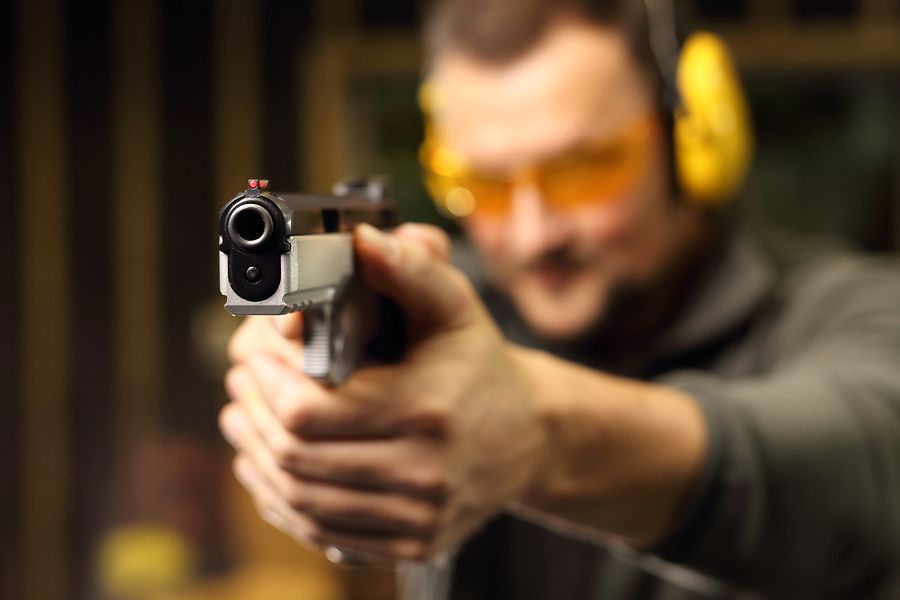Gregory Kielma • December 16, 2024
6 Mistakes That Turn a Self-Defense Shooting into a Legal Nightmare

6 Mistakes That Turn a Self-Defense Shooting into a Legal Nightmare
Gregg Kielma
FFL-Firearms Instructor First Aid Fundamentals Instructor-Gunsmith-AED Defibrillator Sales
A self-defense shooting is a chaotic, life-altering event. While surviving such an encounter is paramount, your actions in the immediate aftermath can either protect or ruin your legal standing. Avoiding certain mistakes can mean the difference between walking free or facing a lengthy legal battle. Here are six critical errors to steer clear of after defending yourself with a firearm.
1. Holding Your Firearm When Police Arrive
When law enforcement responds to a shooting, officers often have minimal information. If you’re holding a firearm, they might mistake you for the threat. Even off-duty police officers are trained to disarm themselves when uniformed officers arrive. If it’s safe to do so, secure your weapon somewhere nearby – like a drawer or glove compartment – before they arrive. The last thing you want is for the police to misinterpret the situation and put you in danger.
2. Leaving the Scene
It might be tempting to leave the scene of a self-defense shooting to avoid legal complications, but doing so could escalate the situation into a murder investigation. Today’s technology – cell phones, surveillance cameras, and witnesses – makes it nearly impossible to remain anonymous. If you’re not in immediate danger, staying at the scene and waiting for law enforcement is crucial. Fleeing can make authorities question your actions and motives, even if your actions were justified.
3. Screaming on the 911
When calling 911, stay calm and provide clear, concise information. While panic is natural after such an event, yelling or screaming into the phone can confuse the dispatcher and lead to inaccurate details being relayed to responding officers. State what happened, describe yourself, and give your location. For example: “I was forced to defend myself against an attacker. I’m wearing a blue shirt and black pants, and I’m at 123 Main Street. Please send medical help and police.”
4. Making a Detailed Statement to Police
After a shooting, your body will be flooded with adrenaline, making it difficult to recall events accurately. Providing a detailed statement in this state can lead to inconsistencies that may harm your case later. Instead, give a brief statement such as, “I was in fear for my life and acted in self-defense.” Then, request to speak with an attorney before answering further questions. This approach not only protects your rights but also ensures you don’t unintentionally incriminate yourself.
5. Treating the Police as Allies or Enemies
Law enforcement officers are there to investigate the scene, not to take sides. While many officers are pro-self-defense, assuming they’re automatically on your side can backfire. At the same time, treating them as adversaries can create unnecessary tension. Remain polite and respectful but avoid oversharing or trying to justify your actions without legal counsel present.
6. Tampering with Evidence
It’s an instinct to want to secure a weapon left by the attacker, especially if it’s loaded. However, touching or moving evidence can cast doubt on your story and complicate the investigation. Unless it’s necessary for safety reasons, avoid altering the scene. Let law enforcement find the evidence exactly as it was to ensure it corroborates your account of the incident.
The Bigger Picture: Preparing for the Aftermath
Understanding how to handle the aftermath of a self-defense shooting is just as important as knowing how to defend yourself. Being mentally prepared for the legal and emotional consequences can save you from additional trauma. Here are a few key takeaways to keep in mind:
Always Have Legal Representation
Organizations that specialize in self-defense legal protection can be invaluable. Having an attorney on-call ensures you’ll receive immediate advice on what to say and how to handle the situation. This support can make all the difference in navigating the legal system.
Handling Emotional Fallout After a Self-Defense Shooting
A self-defense shooting doesn’t just end when the attacker is neutralized; the emotional aftermath can linger long after the legal proceedings are resolved. It’s normal to feel a wide range of emotions, including fear, guilt, and anxiety, even when your actions were justified. Seeking professional help to process these emotions can make a significant difference in how you cope with the incident. Mental health professionals, particularly those experienced in trauma, can provide tools to navigate the psychological impact of a life-or-death encounter.
Why Documentation Is Critical
After the dust settles, having thorough documentation of your training, firearm ownership, and any situational preparation can help your legal defense immensely. Keeping records of firearm safety courses, self-defense training, and even the steps you’ve taken to understand the law in your area c an demonstrate to a jury or prosecutor that you’re a responsible gun owner. Such evidence can bolster your case and counter any narrative that paints you as reckless or impulsive.
Civil Lawsuits: The Hidden Risk
Even when you’re cleared of criminal charges, you may face civil lawsuits from the family of the attacker. This can be a financially and emotionally draining process, especially if you’re unprepared. Protecting yourself through self-defense insurance or a legal protection plan is one way to mitigate this risk. These plans often cover legal fees and provide access to expert attorneys who specialize in self-defense cases, ensuring you’re not fighting alone.
Every Detail Matters
From what you say to how you act, every detail following a shooting will be scrutinized. Preparing ahead of time – through education and understanding the legal landscape – can be the key to protecting your freedom and reputation.
A self-defense shooting is a harrowing experience, but avoiding these six mistakes can help ensure that you survive not just the confrontation, but the legal aftermath as well.
Gregg Kielma
FFL-Firearms Instructor First Aid Fundamentals Instructor-Gunsmith-AED Defibrillator Sales

More Mixed Signals From The U.S. Justice Department On Second Amendment Support We’ve reported lately how the U.S. Department of Justice (DOJ) seems to have a somewhat schizophrenic attitude when it comes to supporting the Second Amendment. On one hand, the DOJ claims to be doing everything it can to restore Americans’ 2A rights. On the other hand, DOJ attorneys will defiantly argue in support of an obviously unconstitutional infringement. In late November, the Firearms Policy Coalition (FPC) and Second Amendment Foundation (SAF) lambasted the DOJ for trying to limit a critical Second Amendment court ruling. After a court ruled that the nationwide ban on concealed carry in post offices is unconstitutional, the DOJ filed a motion to limit the scope of the injunction to only the named individual plaintiffs and to members of SAF and its partner organizations, but only to those who were members when the complaint was originally filed and who have been identified and verified. In other words, the government wants to keep the ban intact for the rest of America’s lawful gun owners. “The critical thing to remember here is that the government is fighting tooth and nail to continue enforcing an unconstitutional law against as many people as possible,” SAF Executive Director Adam Kraut said. “The DOJ’s position that it would be ‘impossible’ for it to know who was protected by the injunction without a membership list is just plain silly. If officials want to know if someone found to be carrying at a post office is a SAF member, they can simply ask.” Less than a week later, Reuters published information about a leaked DOJ plan to expand gun-rights protections with a new office in its civil rights division dedicated to enforcing the U.S. constitutional right to bear arms. The office, called the Second Amendment Rights Section, is expected to open on December 4 and will be dedicated to investigating local laws or policies that limit gun rights, something the Trump Administration has promised since its first week in office.

Michigan Governor Whitmer Surprise: Whitmer’s Anti-Gun Task Force Says Stricter Gun Laws Are The Answer To Violence Mark Chesnut “Garbage in, garbage out” is an old computer science axiom that describes how flawed, biased or poor-quality input will produce equally flawed, biased or poor-quality output. Of course, the principle doesn’t only apply to computer science. The entire gun control world often operates on this same premise. So, consider how unsurprising it truly is that a task force that Democrat Michigan Gov. Gretchen Whitmer created to make policy recommendations to curb violence is urging state lawmakers to ban the possession of so-called “assault weapons” and “large-capacity” magazines. According to a report at michiganadvance.com, Dr. Natasha Bagdasarian, the state’s chief medical executive and the task force’s chair, said the group used a “public health” approach to addressing “gun violence” in the state. “There are a lot of issues here that have not historically been thought of as public health issues, and only when we’ve taken this really comprehensive public health approach have we been able to implement real change,” Bagdasarian told the newspaper. “Gun violence is one of those issues.” It’s easy to immediately see how much garbage went into this project, resulting in the garbage that came out. First, Whitmer tasked the group with finding an answer to the “gun violence” problem. That is, indeed, garbage.

Florida: Pro-Gun Bill Repealing Adult Age Discrimination Advances to House Vote Yesterday, the House Judiciary Committee voted 13-7 to favorably report pro-gun House Bill 133, which restores the ability for young adults to lawfully purchase firearms. The bill now heads to the full House, where it is eligible for a vote when the 2026 regular session begins in January. House Bill 133, sponsored by Rep. Tyler Sirois, restores the ability for young adults to acquire firearms by lowering the minimum age requirement to purchase from 21 to 18. Since 2018, Florida has completely banned 18-to-20-year-olds from purchasing a firearm of any kind, for any purpose. A young adult in violation faces stiff penalties, including up to five years of imprisonment, a fine of up to $5,000, or both. On May 16th, the NRA filed a petition for a writ of certiorari in NRA v. Glass, requesting that the U.S. Supreme Court hear its challenge to Florida’s law prohibiting adults under 21 from purchasing firearms.

Brady X Poster Gets Undies In A Bundle Over ‘Less-Than-Lethal’ Weapons Proposal Mark Chesnut When an organization goes somewhat berserk on social media, passionately stringing post after post together ostensibly to make some kind of point, you’d normally figure that topic is probably a top priority of that group. That’s why gun-ban group Brady’s recent freak out over less-than-lethal weapons is somewhat bewildering. Brady: NONSENSE Brady, formerly called Handgun Control Inc. before leaders learned that most Americans were against “controlling” handguns, has never seen a gun control scheme that it didn’t embrace. But until the recent flurry of social media activity, so-called less-than-lethal weapons didn’t seem to be on the group’s radar much. That changed big time on November 19, when whoever was handling the organization’s X (formerly Twitter) account. “While the world focused on the Epstein files, Congress took up a dangerous bill that sponsors say is to help law enforcement get greater access to ‘less-than-lethal’ weapons,” Brady posted in a typical manner critical of anything seemingly in the pro-self-defense category. “In reality, it deregulates dangerous weapons to help a billion-dollar weapons industry make more money.” That’s all well and good, but the author seemed not to be able to let the matter go, soon posting more on the topic just a few minutes later. “This bill isn’t from a well-intentioned lawmaker or a group working to prevent deadly police violence,” Brady posted. “It’s backed by the manufacturers of so-called ‘less-than-lethal’ weapons, like tasers, who have started making products that are appropriately classified as guns under the law.” Still apparently not having said enough, the Brady writer entered rant mode with yet a third post a short time later. “In their effort to skirt the regulation of their products, this bill would narrow the definition of firearm and open a new market for untraceable ghost guns, which have already led to thousands of deaths in the last decade,” Brady posted.

Extremely Troublesome Department Of Justice Brief Draws Stark Warning From GOA Mark Chesnut A bold brief, recently filed by the U.S. Department of Justice (DOJ) in a case challenging the National Firearms Act (NFA), has one gun-rights organization sounding an alarm. According to Gun Owners of America (GOA), on November 20, the DOJ, in the case Silencer Shop Foundation v. ATF, filed an “outrageous brief that embraces an alarmingly expansive theory of federal authority.” That assertion runs directly afoul of President Donald Trump’s promise to protect the Second Amendment for all Americans. In responding to GOA and GOF’s “One Big Beautiful Lawsuit,” the DOJ treats Congress’ removal of the historic $200 tax as a pretext to rewrite the limits of congressional power, advancing an argument that would open the door to federal regulation far beyond anything the Framers intended. “GOA and GOF condemn Attorney General Pam Bondi and President Trump’s Department of Justice (DOJ) for doubling down on enforcement of an archaic and unconstitutional law while simultaneously offering legal theories that would expand federal power to historic levels,” GOA said in a news release revealing the DOJ’s actions. “This is especially striking from an administration that had promised to respect the Second Amendment and review burdensome agency rules.” As GOA further explained, the implications of the DOJ’s stance are immediate and ominous.

If you have a concealed carry permit and you have a gun with you, and you walk into or need to go into a store that doesn’t allow guns, what do you do? Says Kielma, this is an easy one for me. I do not and never will enter a place that has ca no "firearms allowed" , ever. I’ll spend my hard-earned CASH SOMEPLACE ELSE. If I miss the sign by accident and enter then, I’ll suffer the consequences. NOTE: Please check for signs on doors. Keep your firearm concealed and no one should bother you if you miss the door sign. Let’s take a look at BOB an avid reader of my website would do: I have a concealed carry permit, and I carry concealed all the time. Concealed means unseen. Unless they have metal, detectors and security guards wandering, I simply ignore the signs. The difference would be places whereby actual law, you cannot be armed on the premises. Federal and government buildings for instance. True story. We went to see a show. We had to park some distance away and when we got to the place to present our tickets… you guessed it, they were wanding everybody. My wife says to me, “well, you've got your ticket and seat assignment, hurry back.” I just nodded and stayed in line. When she got up there, they wanded her and glanced in her purse. I was next. I told the female doing the wanding that I was going to set things off because I had a lot of metal on me. I then pulled a suspender strap from under my coat and showed her the metal concho on it. She told me OKAY, swiped the wand down my front and back - it went off - and she waved me through. When we took our seats my wife side mouths to me, “one day you're going to have to tell me how you did that.” “Old Jedi mind trick I replied, these are not the droids you're looking for.” What was I carrying? Full size main firearm with two backup magazines, backup firearm with two speed strips, Leatherman Wave, Swiss Champ, Thru Nite flashlight, neck knife and a couple other pocketknives and a smartphone. Several points: No place on the tickets did it say no firearms or pocketknives. Matter of fact there was no mention of security. This was a public venue. I had already paid to be there. My permit was valid in the State I was in. Concealed means just that. My 4th Amendment rights didn't evaporate with my purchase of a ticket. The fact I got through security meant others may have too. Was this event taking legal responsibility for my security and that of my family? Of course not. As we were leaving my son said, “so much for their security.” He was right. Security unless you have the Secret Service providing it is pretty much an illusion/delusion.

What's more powerful than the .308 and .30-06 for certain types of hunting? How does it compare? What do you think? .45 70? Gregg Kielma .45-70 ? As a straight-walled cartridge, it and similar types of ammunition are favored for deer in states were bottlenecked cartridges, such as 30–06, cannot be legally used. In its original loading, it delivers 2,221 joules of energy but has been loaded much hotter to the point that 3800–4600 joules are possible. A standard .308 load delivers around 3600 joules and 30–06 around 3800. It is a good example of “knockdown power" type of ammunition in that a large chunk of lead, traditionally not moving as fast, hits hard because of its mass. More modern cartridges made use of smaller bullets and smokeless powder to create ammunition that hits hard with a moderate projectile and much higher velocity. The tradeoff is that .308 and .30–06 have far less muzzle drop at long ranges. Off the top of my head, the projectile drops something like 4′ at 400 yards, but it has been a while since I looked that up. .308 is much flatter shooting. Just my opinion. What do you think?

Is it safe to unload a handgun every time we get home? Gregg Kielma This depends on several different situations. You must find what works better for you, and your family. They did that for years in the military. They would safe and clear everyone’s weapons before they went into the mess halls. They would take a pistol out of a perfectly solid holster that could be dropped out of an aircraft and not go off and proceed to pull the slide and the trigger into a clearing barrel to make sure it was empty. Occasionally it wasn’t. It was a bad idea. So eventually they stopped having people do it and do you know what!? No one was shooting guns in the mess hall. Every time you handle or have people handle guns they can go off. Especially WHEN PART OF THE PROCEDURE IS PULLING THE TRIGGER. A better procedure is NOT TO PULL THE TRIGGER. Again, if your weapon is loaded, the firearm you carry should be. You shouldn’t unload it unless you are cleaning it or are going to swap it out with another carry weapon in the gun safe. It is said that you do need to release spring tension on magazines, it is said by all the old guys, but that is every few years and you should be cleaning any gun more often than that. Loading and unloading your weapon every single day is something I suppose you could do. I wouldn’t if I wasn’t being paid to do so. My EDC stays loaded for a few months at a time. Then I cleaned it and get it ready for another 3-month tour. Every time you mess with a gun you have the chance of an accidental discharge. It is designed to sling supersonic metal out the front of it. Accidents happen every single day and the way to increase the number of accidents is unnecessary gun handling. Do not push yourself past competence and into complacency. Let’s Take a LOOK: • You do something a hundred times, and you get good at it. • A thousand times and you get great at it. • You do it 6,000 times and you get complacent because you have done it TOO much and that is when you get bit. That is why you can’t do the same job for decades and maintain the same exact level of proficiency. Chances are you may or will get careless.

I have a concealed permit to carry and if I find myself in a threatening situation, can I show it to defuse the threat without it being seen as brandishing even though it resolved peacefully? Gregg Kielma Gregg Kielma gets asked this question a lot. Says Kielma, “I get asked this a lot and can give you what I’d do if I was in a bad situation I didn’t start nor could not avoid or escaped from. Let’s take a look”. Never pull a weapon to threaten and never fire a warning shot in life-threatening situations. If you reveal a weapon, someone might rush you, disarm you, and use it against you. If you are in a life-threatening situation, stay calm and use verbal de-escalation without making threats. If that fails and you're confronted by a violent person, do not let them get close—keep moving back and maintain at least 25 feet of distance. If they get any closer or fail to comply with your instructions, in a loud voice shout, drop your weapon, drop your weapon. As a last resort and only as a last resort, draw your weapon and fire shots at center mass. Continue firing until there is no longer a threat. When you shout "drop your weapon" it lets others know you felt threatened. If a shooting occurs, you will be arrested—do not speak to police without an attorney present. Invoke your 4th and 5th amendment rights. Tell them you'll provide a full statement once you have legal counsel; you only get one opportunity to do so properly. You cannot hesitate in a life-or-death situation. If you do, you will be among the dead. Kielma’s final thought, says Gregg, “please take my training CCW course. I provide a lot of information in the class that is easy to understand and may keep you out of jail and alive.

Indianapolis Pimp Given Three Life Sentences in Federal Prison for Running Sex Trafficking Enterprise and Committing Murder Tuesday, November 25, 2025 U.S. Attorney's Office, Southern District of Indiana Editor's Note: This sentencing occurred on September 25, 2025, but was not published at that time due to government shutdown. Press release posted and made available following the return to normal operations. INDIANAPOLIS- Kristopher McDonald, 37, of Indianapolis, has been sentenced to three life sentences in federal prison. In May of 2025, a federal jury found McDonald guilty of the following eight counts related to his operation of a violent human trafficking enterprise: Count 1: Murder in aid of racketeering activity. Count 2: Brandishing and discharging a firearm during a crime of violence. Count 3: Possession of a firearm by a convicted felon. Counts 4 & 5: Sex trafficking by force, fraud or coercion. Count 6: Enticing an individual to travel in interstate commerce to engage in prostitution. Counts 7 & 8: Travel act; a federal crime to engage in interstate or international travel, for the purpose of furthering certain "unlawful activities.” According to trial testimony, from June 2023 through April 2024, Kristopher McDonald orchestrated and led a human trafficking operation in Indianapolis and other states. During this time, he recruited and exploited women, some from out of state, for commercial sex, maintaining strict control over the operation. McDonald managed all aspects of the criminal enterprise, using force, fraud, and coercion to control the activities of the women. McDonald recruited the women over the internet, making false promises to them to lure them into his enterprise. He then used several means to manipulate and control the women to engage in commercial sexual activity. McDonald limited the victims’ access to the outside world by taking control of their personal identification, cash cards, and cellphones. McDonald threatened the women with physical violence and directly employed violence, including pistol whipping, to compel them to engage in commercial sex. McDonald also caused the women to become addicted to crack cocaine by rewarding them with the drug when they followed his orders and withholding it when they did not make enough money on a given day. McDonald also threatened to kill the victims and their families if they contacted the police. McDonald often compelled the victims to engage in commercial sexual intercourse on nine or ten occasions per day. The trial testimony also established that on October 11, 2023, McDonald murdered another man in furtherance of his human trafficking organization. After the man engaged in commercial sex with one of the victims, McDonald emerged from an adjacent room and demanded an additional $200 from the man at gunpoint. The male victim drew his own firearm in self-defense and shot McDonald . McDonald ran back into the adjacent room, loaded his firearm with a magazine, and shot the male victim eleven times in the back as he attempted to flee the hotel room. McDonald , a previously convicted felon, was not permitted by law to possess the firearm that he used to murder the male victim. “Kristopher McDonald’s reign of terror is over, and our community is safer because of it. This sentence sends a clear message that those who exploit vulnerable individuals through violence, addiction, and fear will face the full force of federal justice,” said Tom Wheeler, United States Attorney for the Southern District of Indiana. “I am grateful for the outstanding work of our law enforcement partners, whose collaboration and dedication made this prosecution possible, and to the survivors, whose strength and courage in coming forward were instrumental to securing justice.” “There is no place in our society for criminals like Kristopher McDonald . The crimes he committed were despicable, outrageous, and cut to the very core of our moral fabric. Life in prison is exactly what he deserves — and ATF could not be prouder of the agents whose relentless work made this outcome possible,” said ATF Columbus Field Division Special Agent in Charge Jorge Rosendo. “Kristopher McDonald wielded violence as a weapon to coerce victims, expand his sex-trafficking operation, and maintain power through fear,” said Adam Jobes, Special Agent in Charge, IRS Criminal Investigation, Chicago Field Office. “His life sentence removes a ruthless predator whose presence threatened the very fabric of our communities—and the importance of that removal cannot be overstated. IRS Criminal Investigation will continue leveraging its forensic accounting expertise to follow the money, dismantle criminal enterprises, and bring violent offenders like McDonald to justice.” The Bureau of Alcohol, Tobacco, Firearms, and Explosives, Internal Revenue Service Criminal Investigation, and IMPD investigated this case. The sentence was imposed by U.S. District Judge Tanya Walton Pratt. U.S. Attorney Wheeler thanked Assistant U.S. Attorneys Bradley Blackington and Michelle P. Brady, who prosecuted this case.















